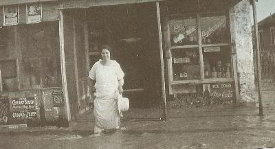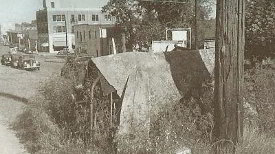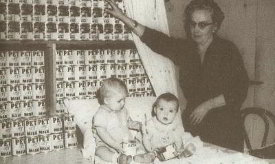Our History Sand Springs has a long history of helping those in need. Sand Springs Community Services (SSCS) was started by local civic clubs and churches in 1928, before the onset of the Great Depression. SSCS, formally known as the Sand Springs Welfare Association, has extended a helping hand to those in need for 80 years.
 |
These pictures of “the line” now known Charles Page Boulevard, show the flood of 1923. The flood came up to Booker T. Washington School at Morrow Road which was later called Sand Springs Kindergarten. Now it’s going to be a pharmacy. Water was also 9 feet deep at Bruner station.Sand Springs was isolated from Tulsa- there was no way in or out!Charles Page, our town founder, set up a make-shift tent camp in Sand Springs Park to assist flood victims. Besides food and medicine, shoes and socks were a pressing need in the camp because of the flood waters. The attitude of reaching out to help our neighbors in need is still strong today. |
 |
More on history
In 1928, just one year after the death of our town father, Charles Page, the community of Sand Springs began to feel the loss of this one man who had carried the burden of the needy of our city. He always had a plan for the orphan, the widow, the down and out, and even the man in trouble and about to lose his home. If Mr. Page learned of it…the order was given, “HANDS OFF.” In fact, he kept the very pulse of all the citizens near his heart.
No one knew this more than the women of Sand Springs, who were working to help the needy and low income families in sickness and in want after the death of Mr. Page.
One of the most active women’s clubs was the Sand Springs’ Woman’s Club. They called a meeting with members of other clubs, together with Rotary and the Chamber of Commerce Board and presented this one big problem, CHARITY! Plans were formulated in 1928; a drive for money, setting up the Board of Directors, and the first President was named, H. Clay Fisk.
Fisk was then the Superintendent of our schools. He gave of his time in getting these members and clubs together, making plans, setting up the by-laws and starting the first charity organization in Sand Springs. Mrs. Packard, the first secretary, was very active in “club work” and knew how to go about organizing and planning for this big project.
In December 1928, we have records of forty families receiving aid for food, clothing, or medical aid and many other services. This did not include transient families. Drives for clothing were started in September 1928 by the Woman’s Club with Margaret Whalen as the President and Mrs. John Bickford as Chairman of the Welfare Committee.
The Great Depression
In 1931, Harrison H. Young, an engineer and member of the First Presbyterian Church became President of the Welfare Board. During this time, the depression was at its height. He called for a committee to work on the problem of food and clothing.
Groceries were bought from wholesale houses and dispensed from a commissary. Large donations of food were collected; especially from the Home farms.
Gardens were planned under the supervision of Rev. Archie Kinion and members of the Church of God. Mrs. Ruth Young, Julietta Harrison and other members of the Woman’s Club, “would go to Tulsa to buy large truckloads of vegetables and deliver them to the canning factory that previously had ceased operation.” Mr. Hubbard donated the jars from the Kerr Glass Manufacturing Company and SS Home gave the use of their Canning Plant. Under the supervision of the canning department of Kerr Glass, hundreds of cans of vegetables and fruit were canned for the SS Welfare Association. Ruth Young remembered “sitting for hours preparing vegetables to be canned and given to the needy.”
A Soup Kitchen was organized at Central School, where under-privileged children were given a good lunch. Although this effort was headed-up by the SS Woman’s Club, according to Ruth Young, “leadership for the Woman’s Club and the SS Welfare came from church memberships who helped to organize, cook and serve these meals as well as working in the canning factories, soliciting door-to-door and business-to-business for funds and clothing. It was indeed a time for ‘all good men (and women) to come to the aid of their country’.”
In 1932 donations and pledges brought $7,984.95. By comparison, SSCS helped almost 1,800 families in 2007 and distribute as much as $5,000 a month in aid in 2008.
| A carpet remnant, scrap wood and an iron headboard on the side of 2nd St. is home to an unfortunate individual during the Great Depression of 1930’s. This community did fare better than most due to its diversified industrial base. |  |
 |
Mrs Deborah Jacobs, reaches for a can of milk for the little ones in the photograph taken in 1951. The Association created the Babies’ Milk Fund to provide basic nutrition to Sand Springs’ tiniest residents. The Welfare Association began when a group of concerned women organized to help local unemployed families during the Depression. The group organized a soup kitchen, canning and sewing drives, and a hot lunch program for Central School. This was the start of SS Community Services. |
On October 4, 1982, the agency applied for and was granted a tax exempt status and was incorporated as the Sand Springs Welfare Association, Inc. on July 1, 1982.
On January 22, 1998, by vote of the Board of Directors, the Articles of Incorporation and By-laws were amended to change the name of the agency to Sand Springs Community Services, Inc. This agency was admitted as a Tulsa Area United Way member agency in 1972 and is currently funded through the Tulsa Area United Way, Lucile Page Trust, and donations from businesses, individuals, churches, and civic organizations. We have grown from one part-time employee to one full-time employee, 2 part-time employees, and a staff of volunteers.
Charles Page believed in the dignity of people and that the goal of emergency assistance should be to help people towards self-support and independence. Sand Springs Community Services, Inc. will continue this proud tradition of serving Sand Springs and its neighbors in need into the next century.
These photos were taken from Images of America, Sand Springs, Oklahoma, by Jamye K. Landis. Other photos are on file in the archives of the Sand Springs Museum and this book is for sale at the museum.


